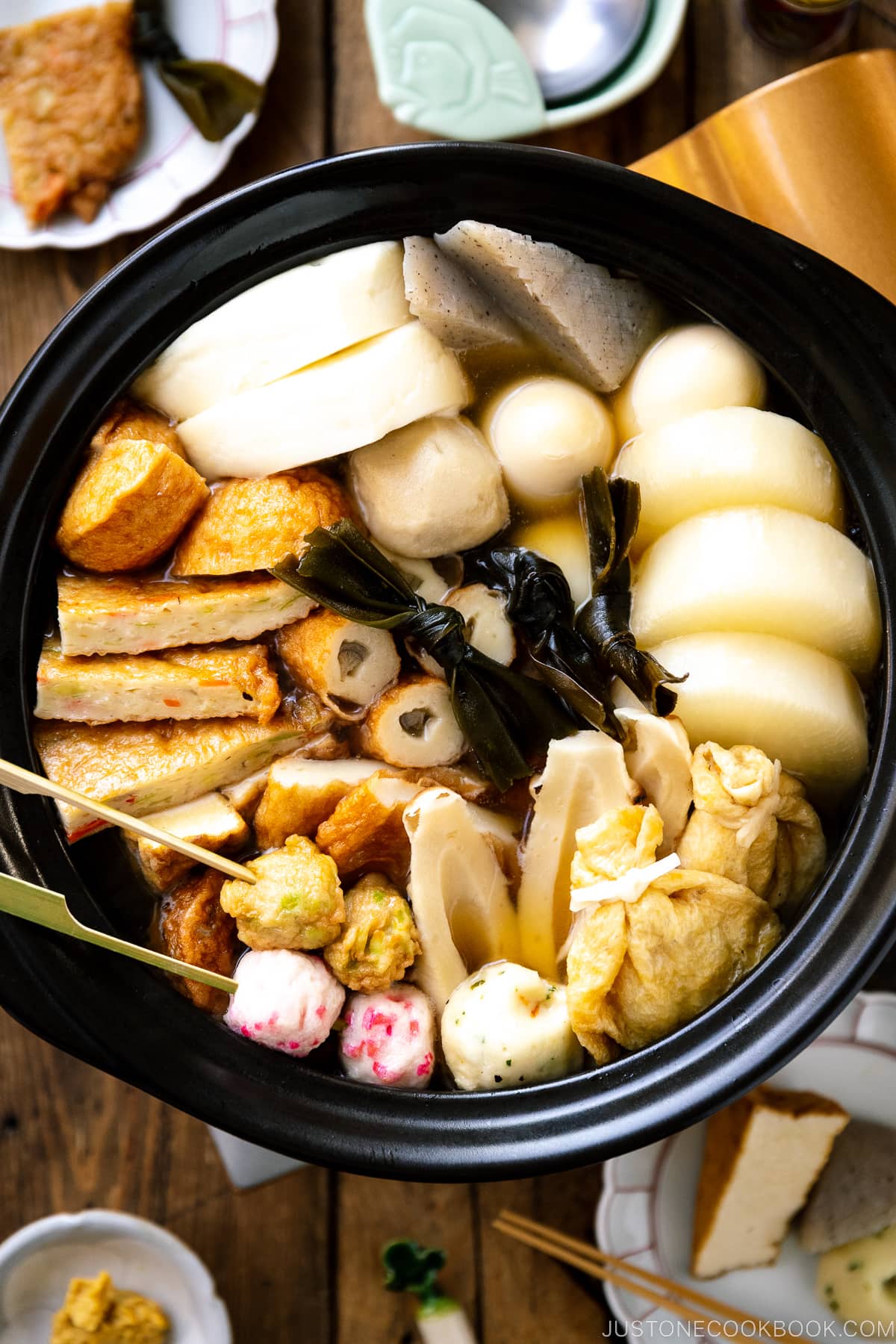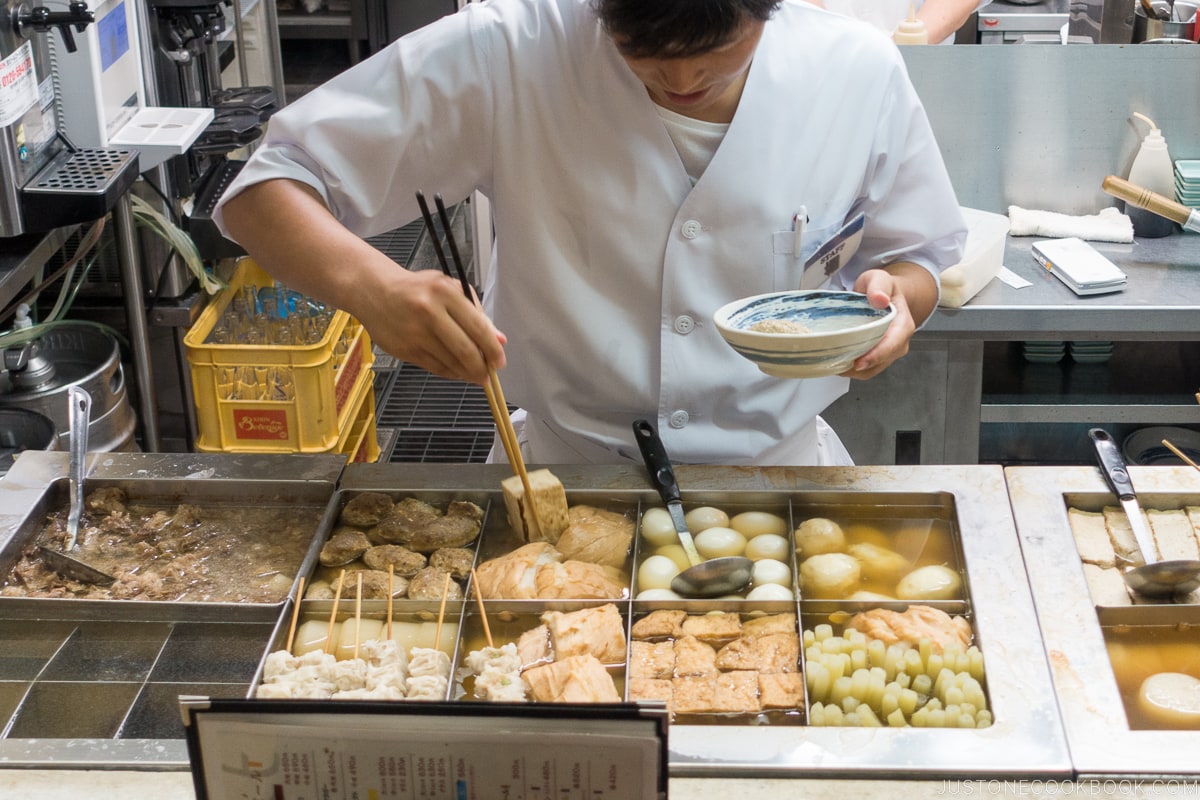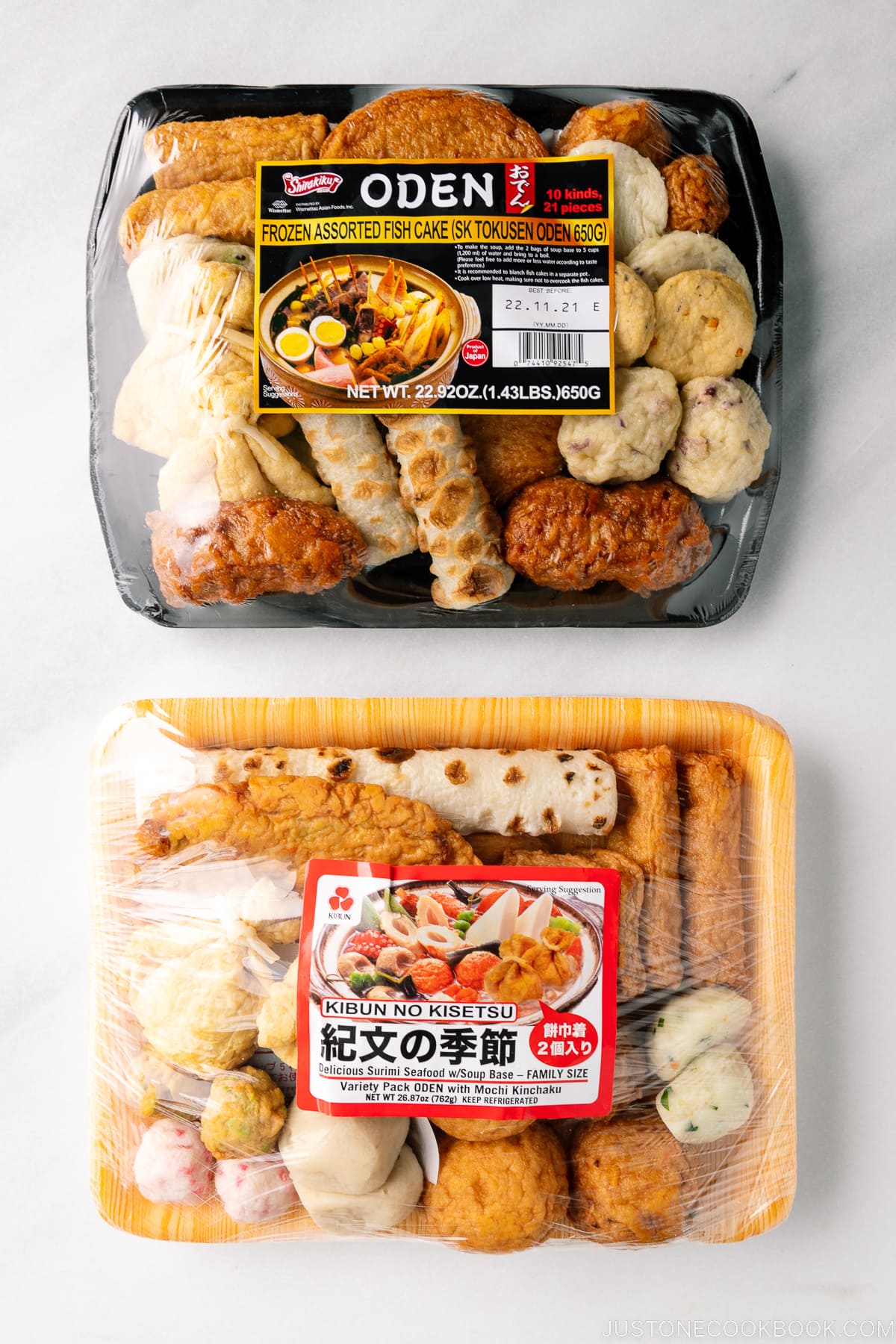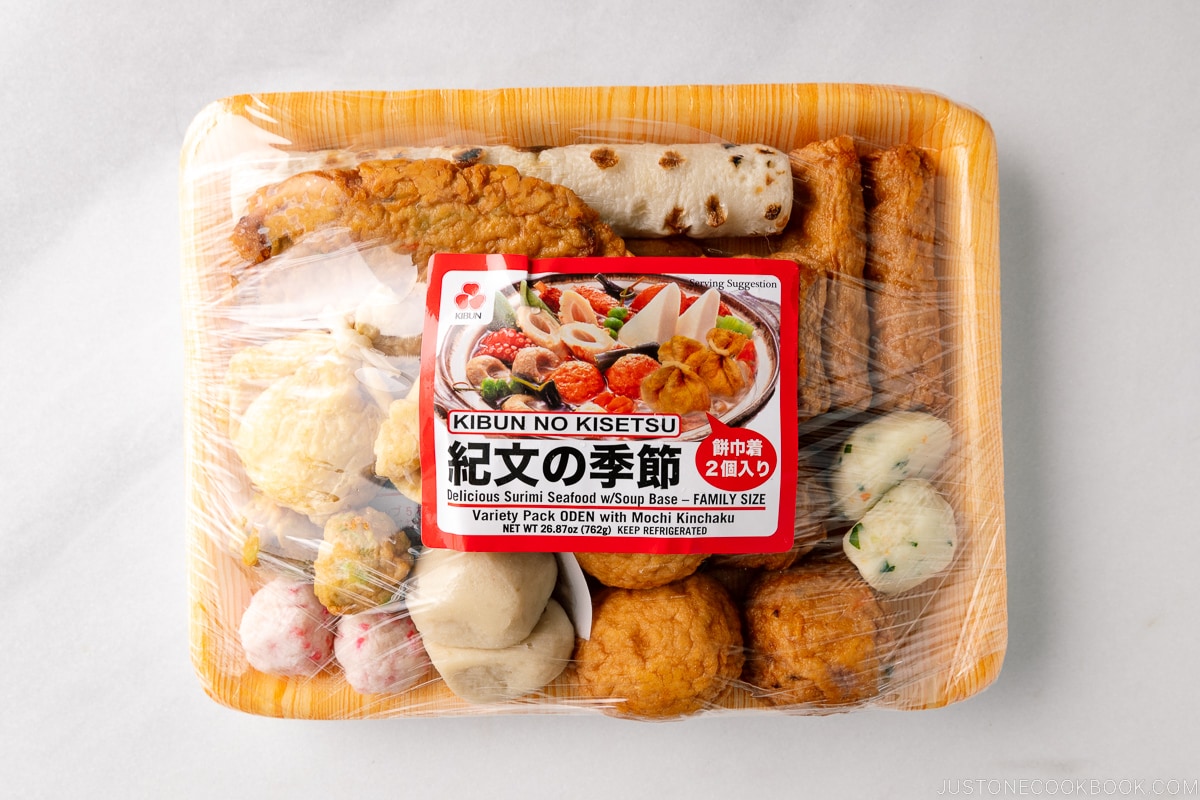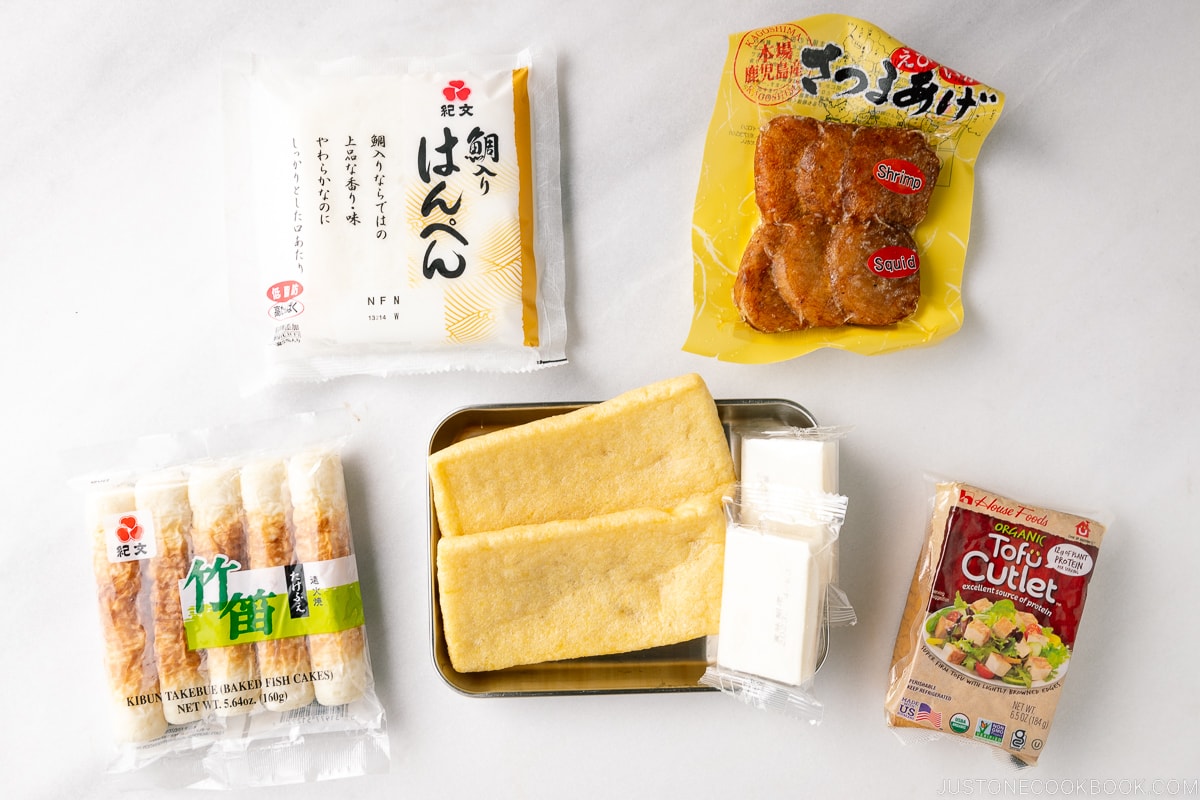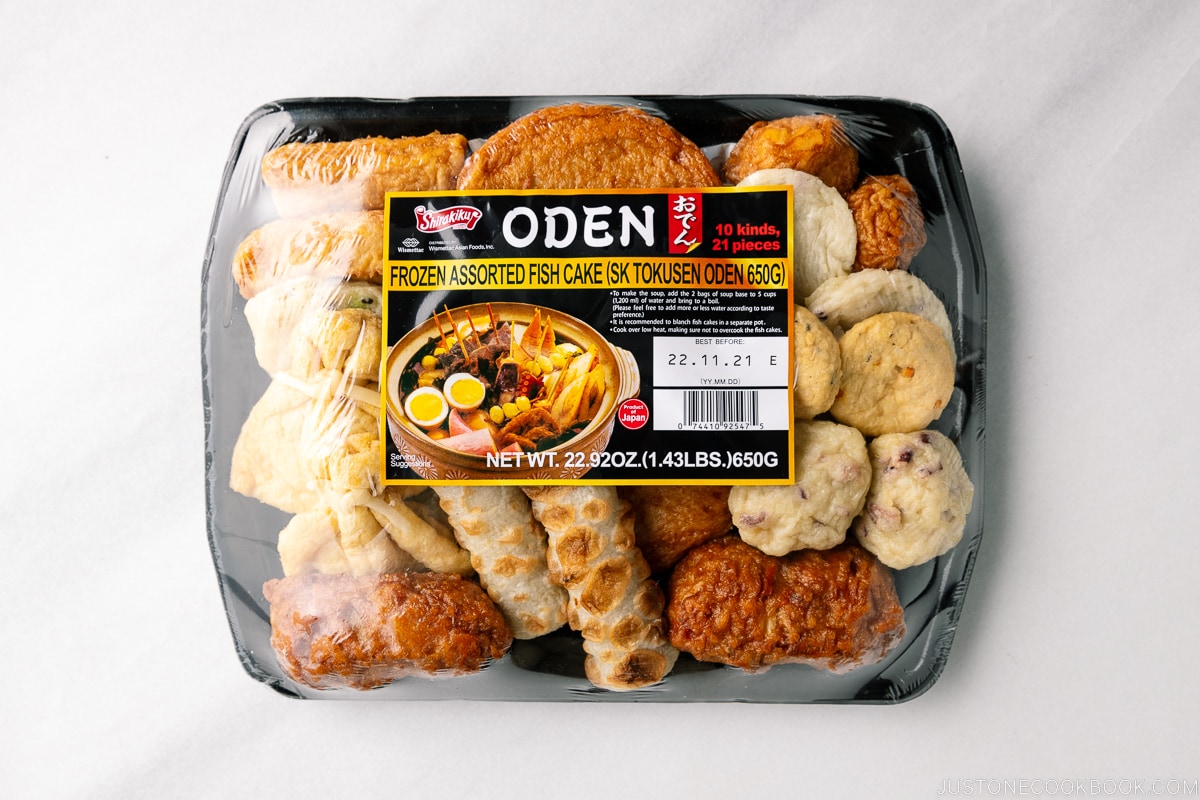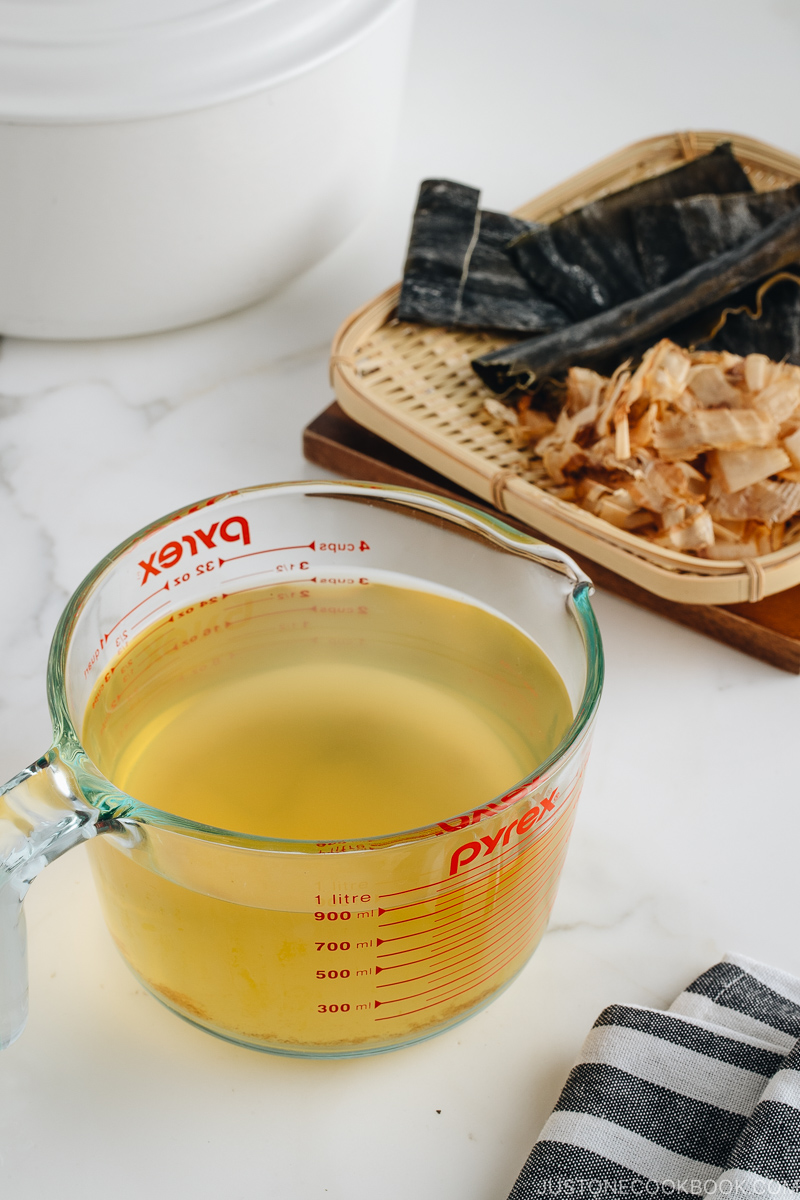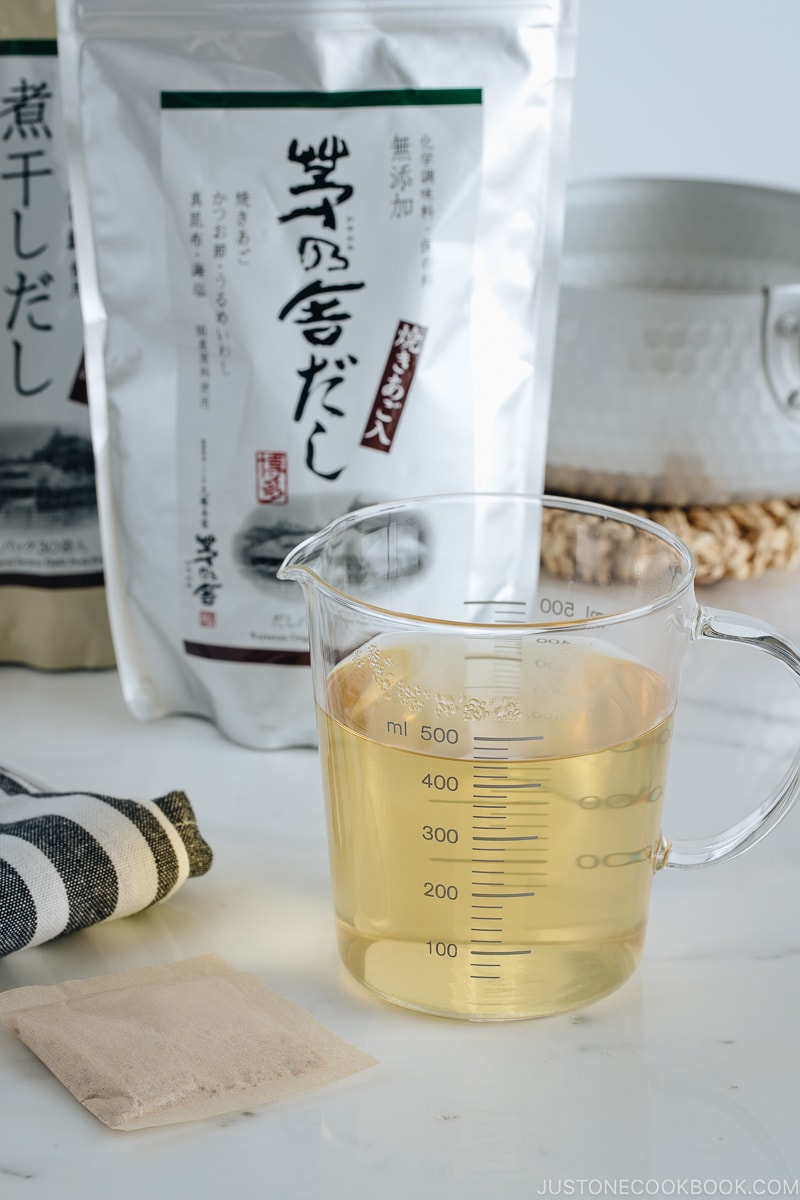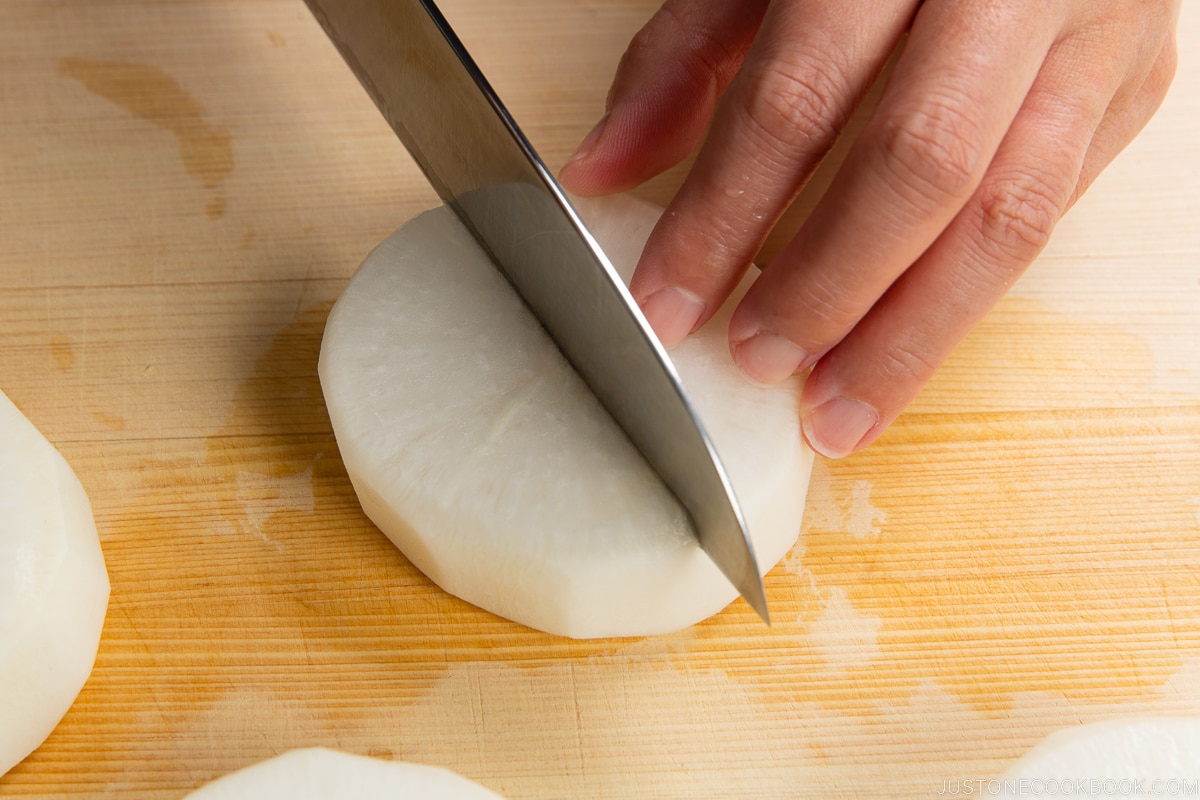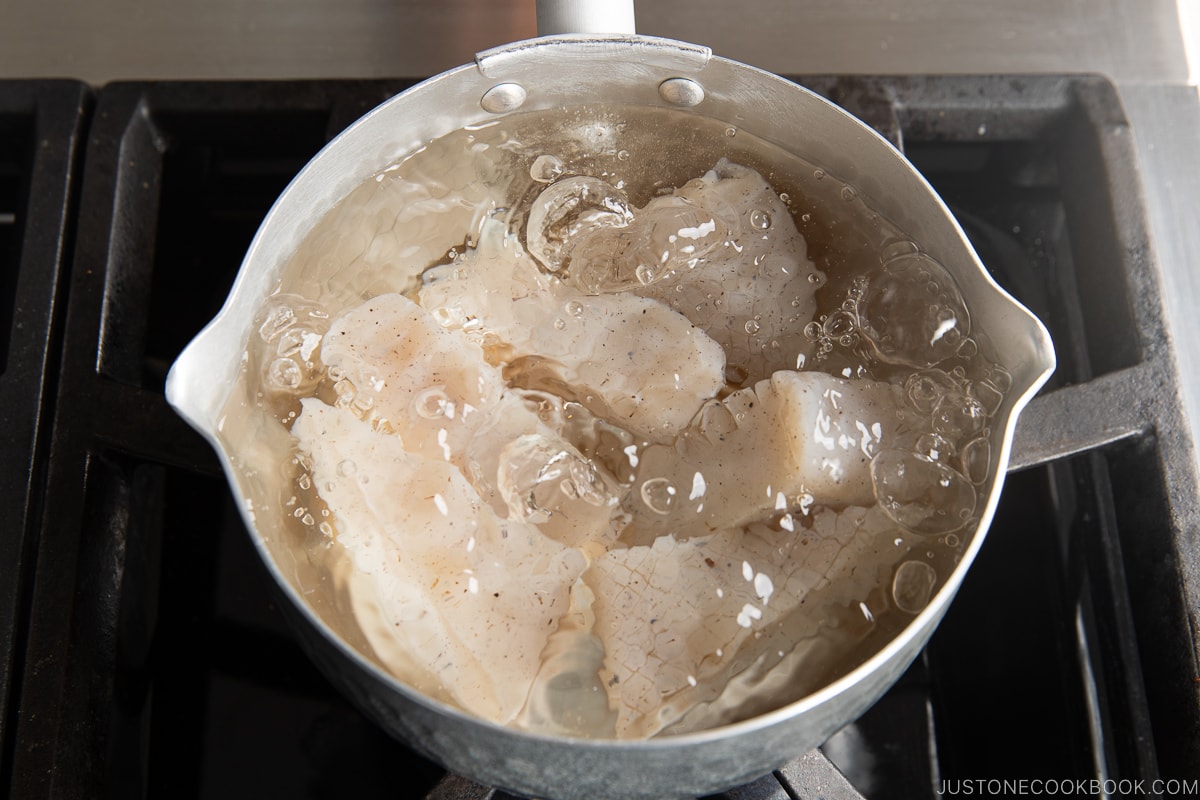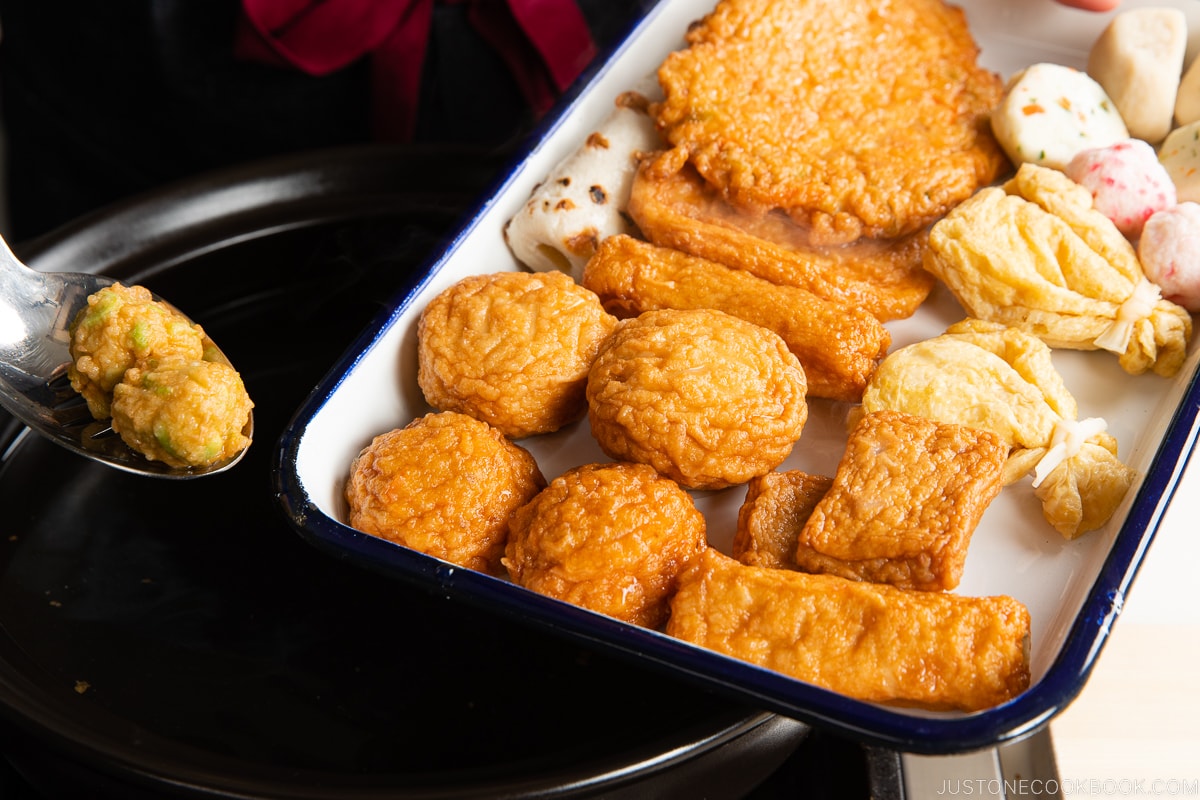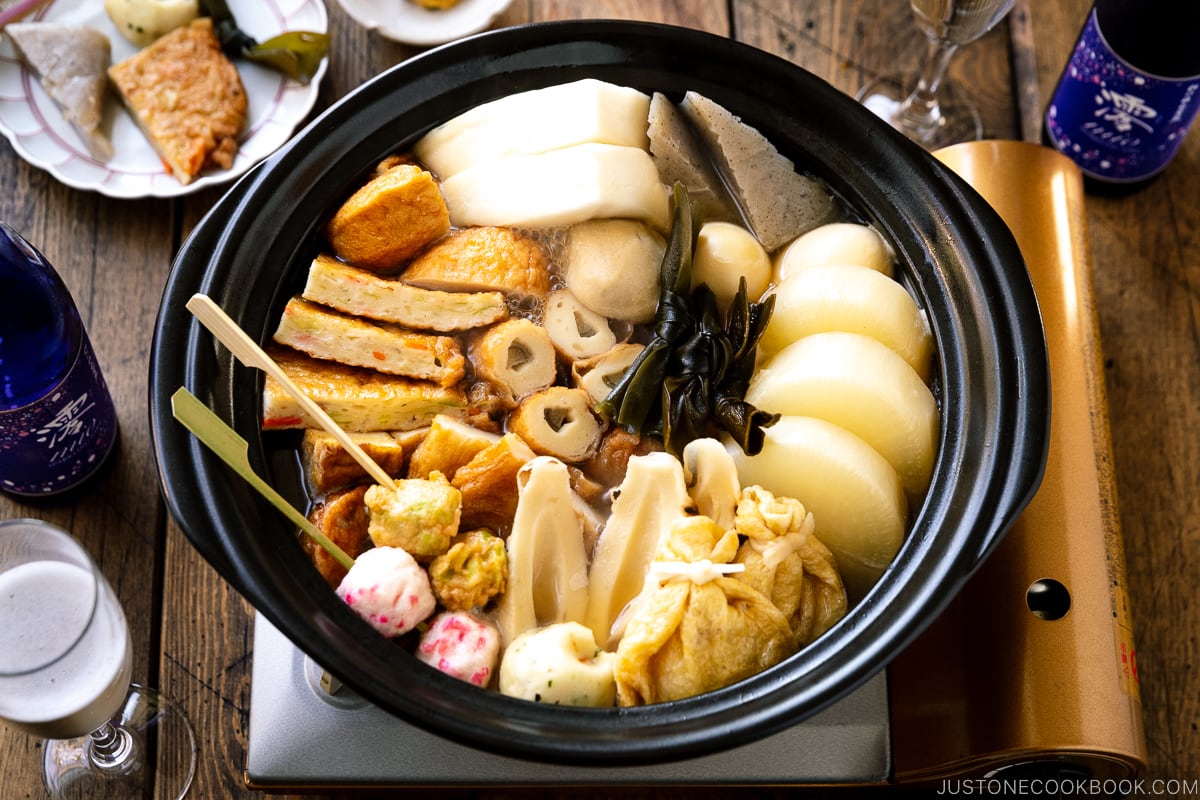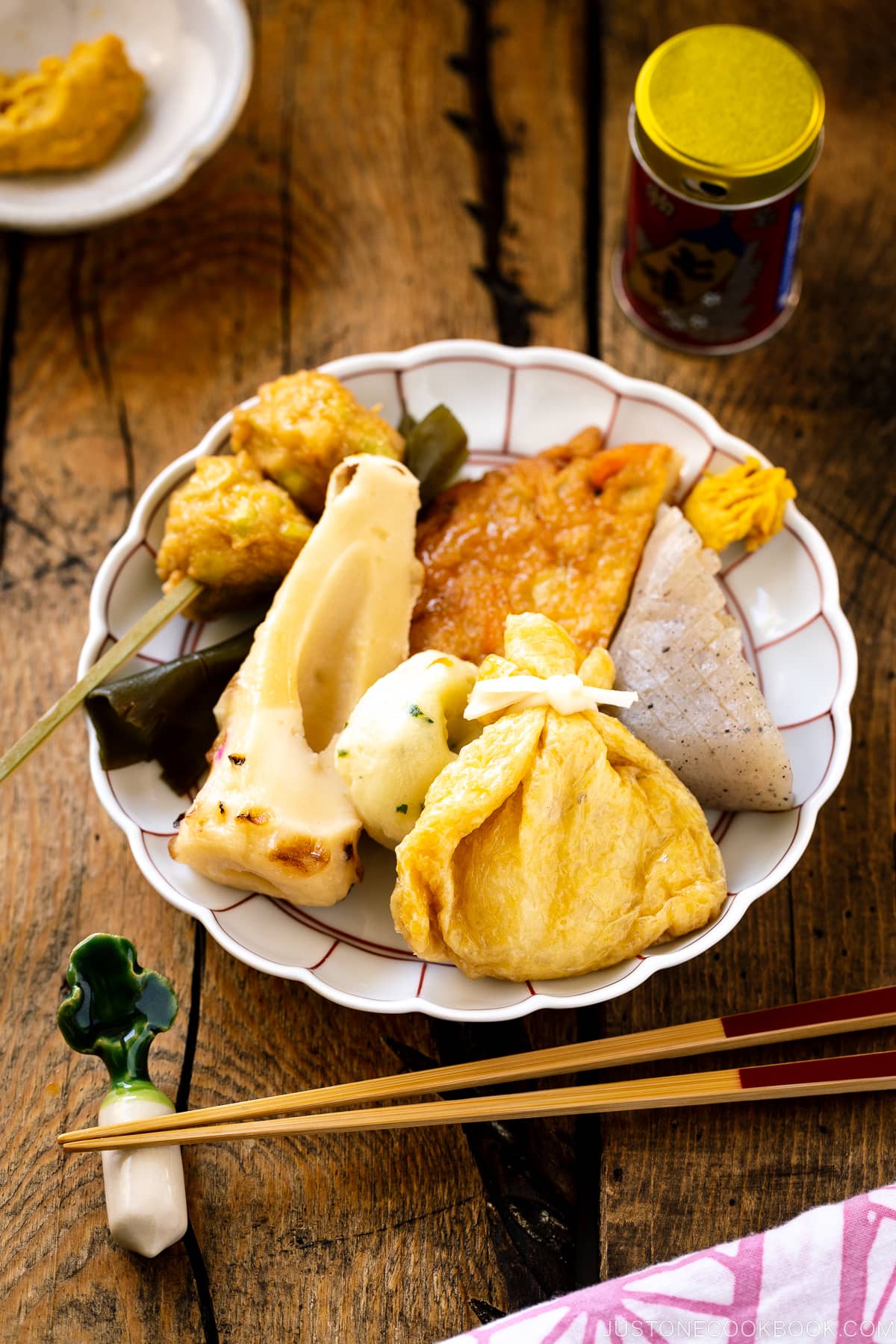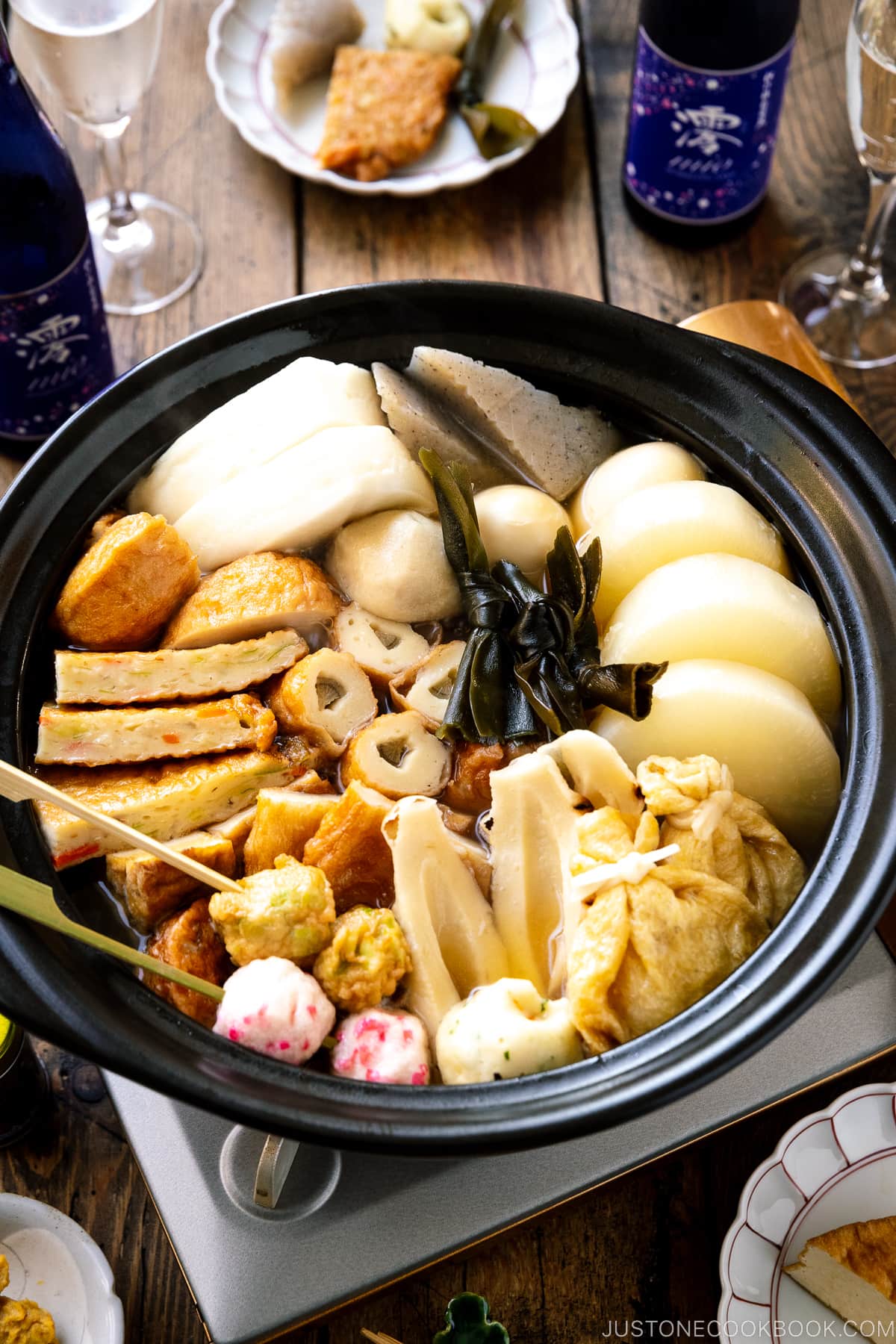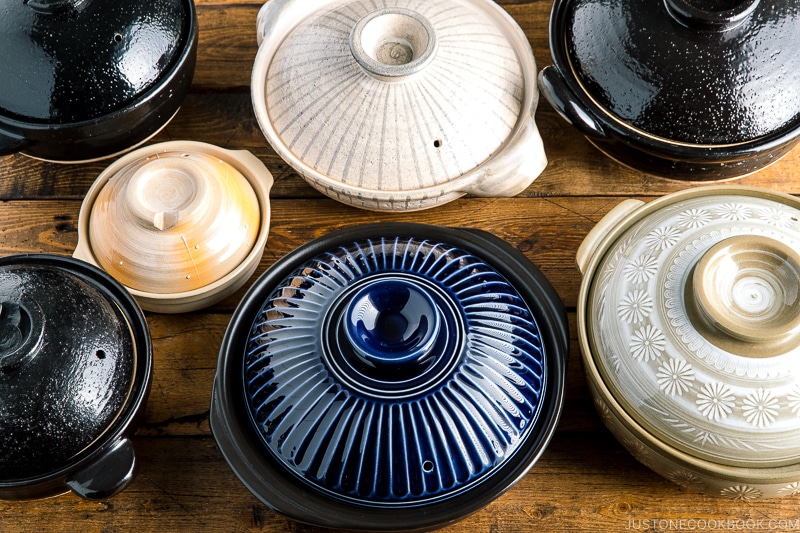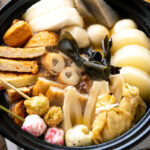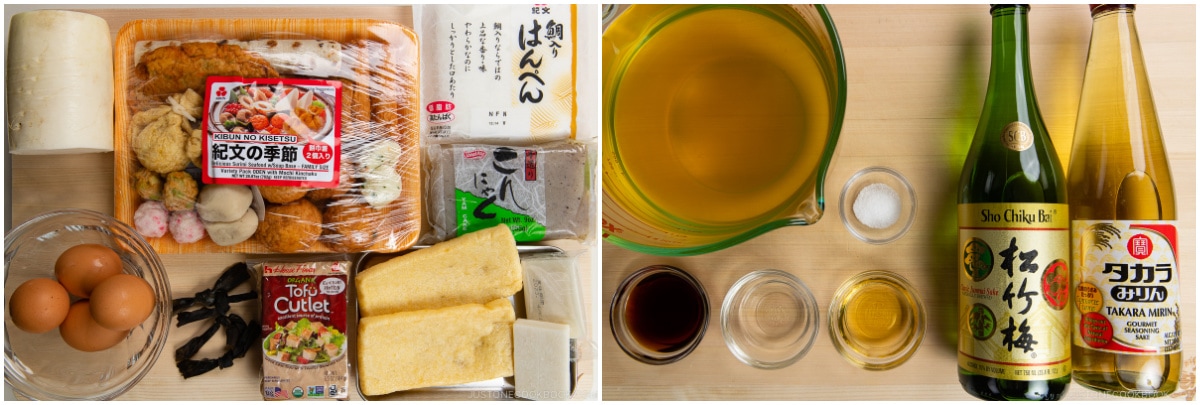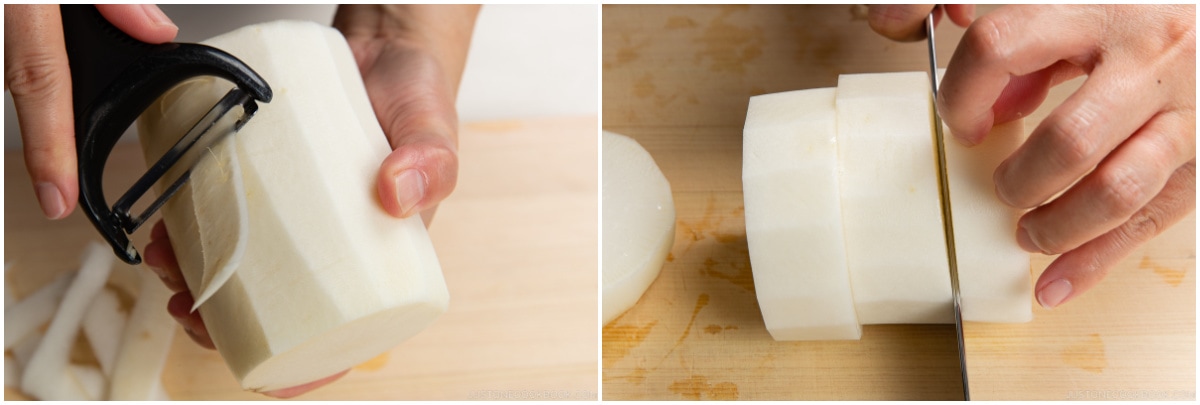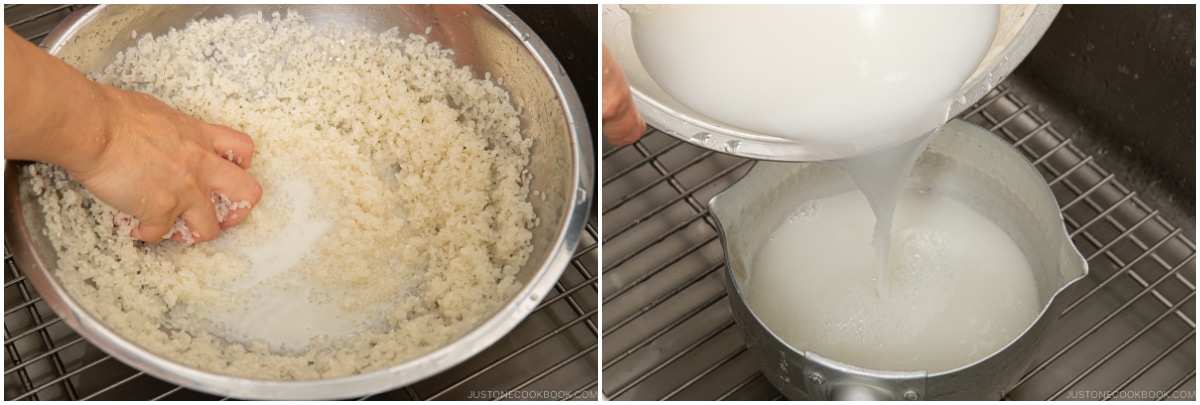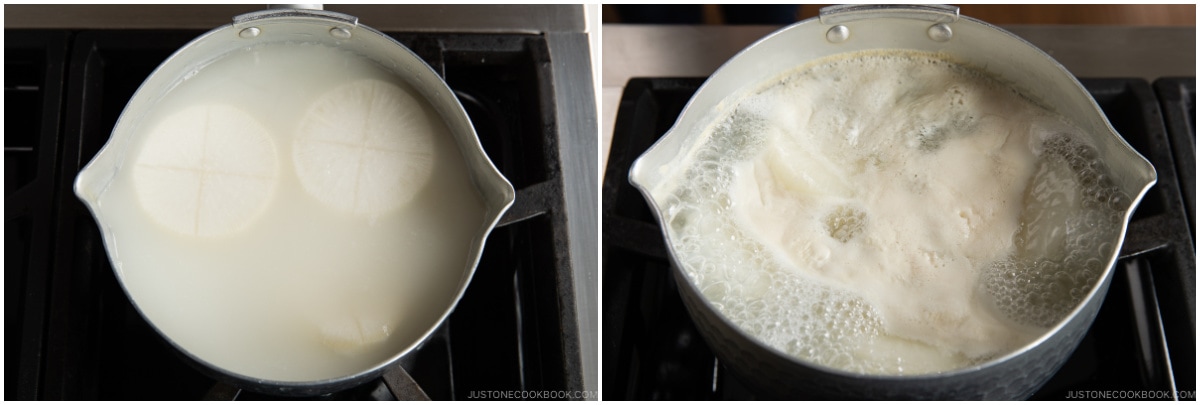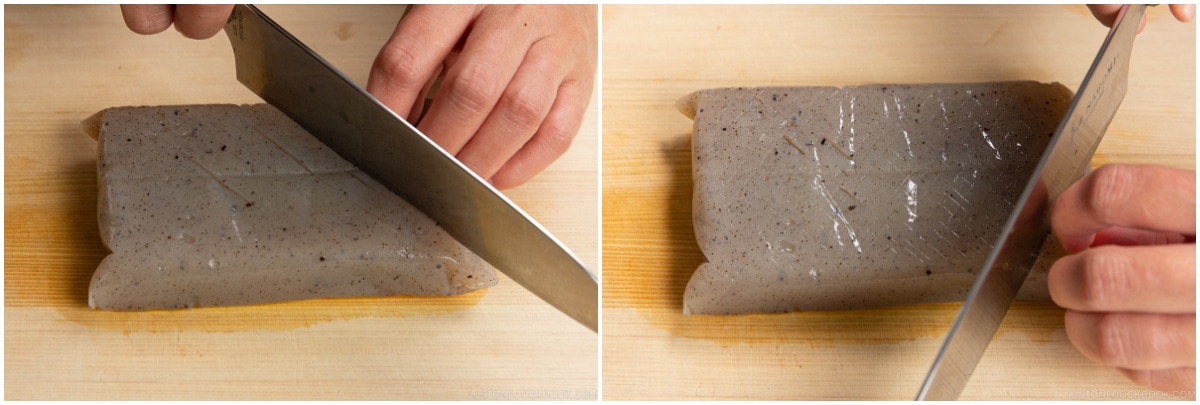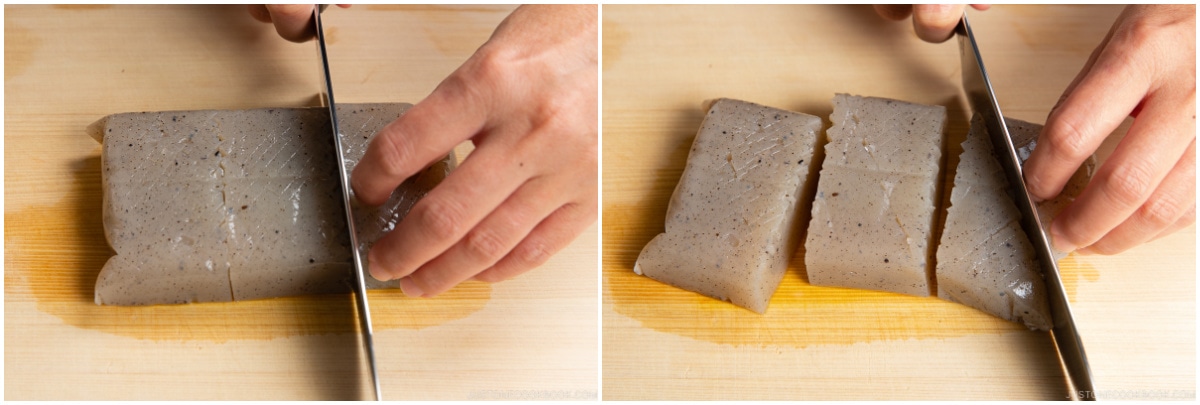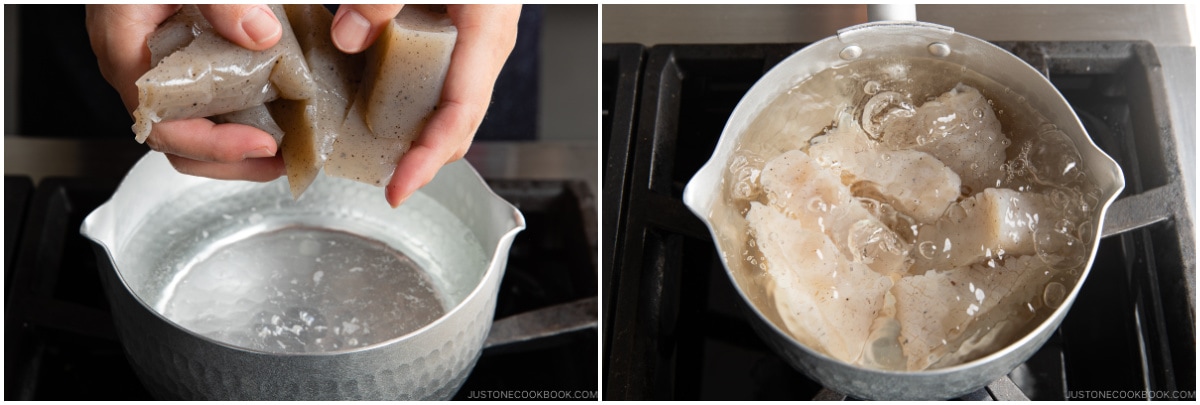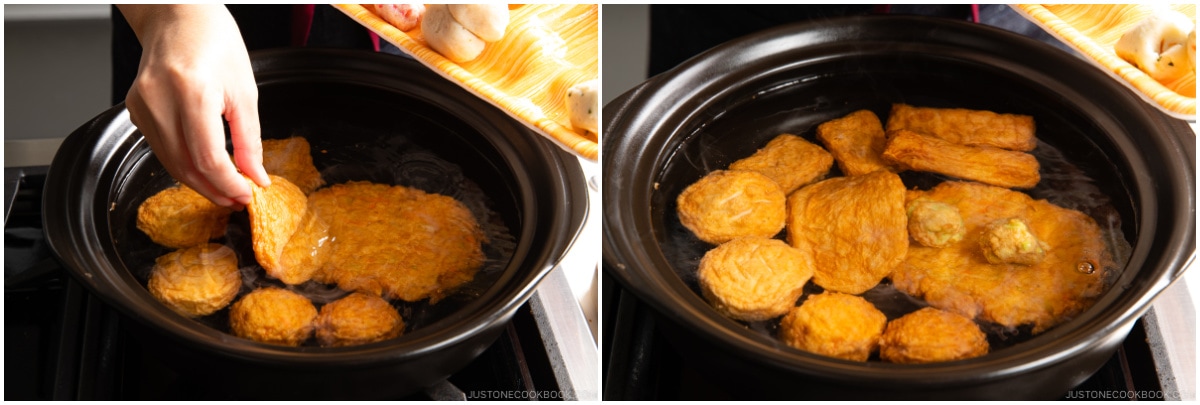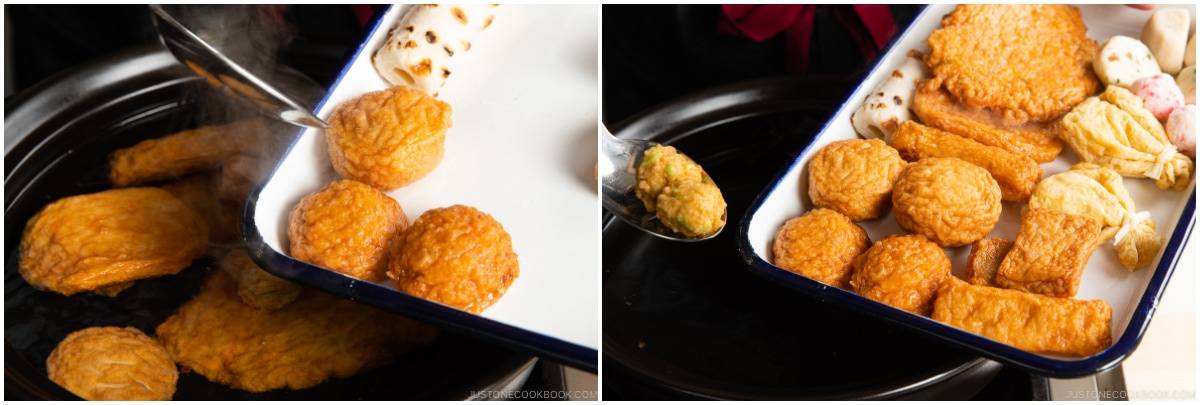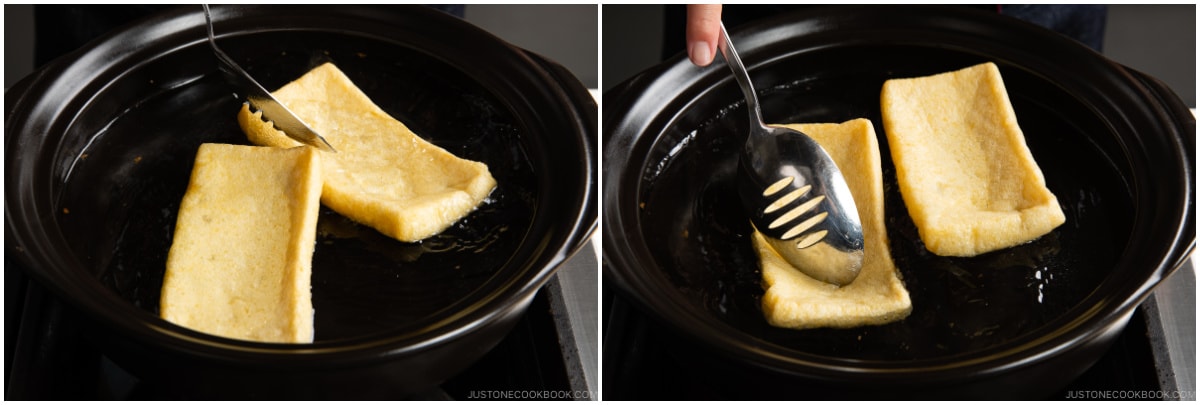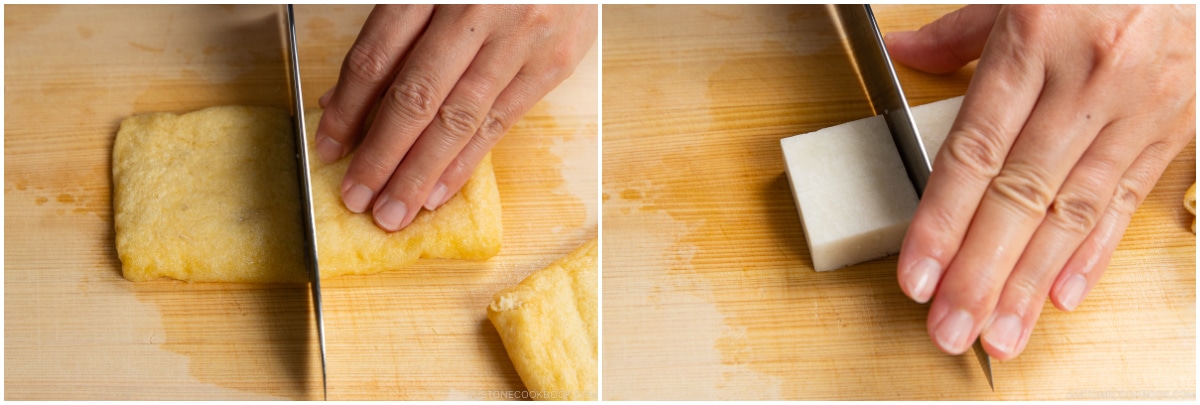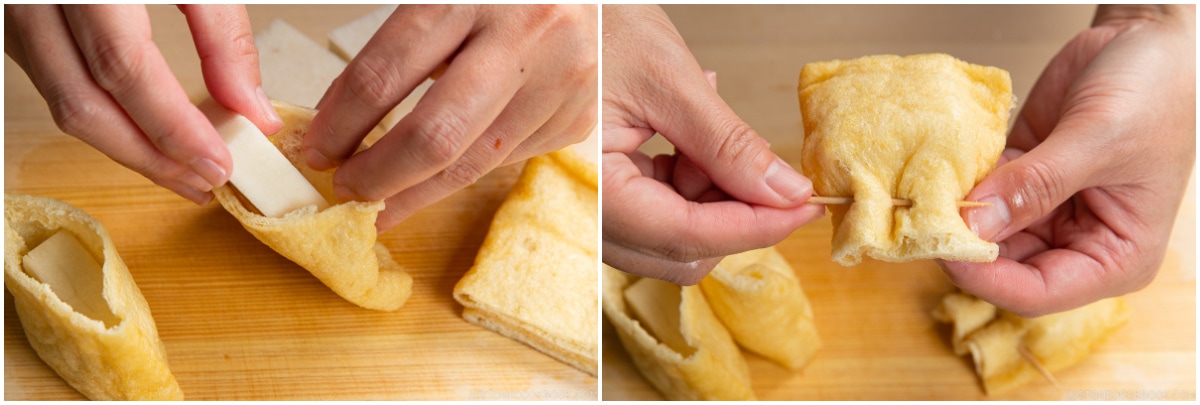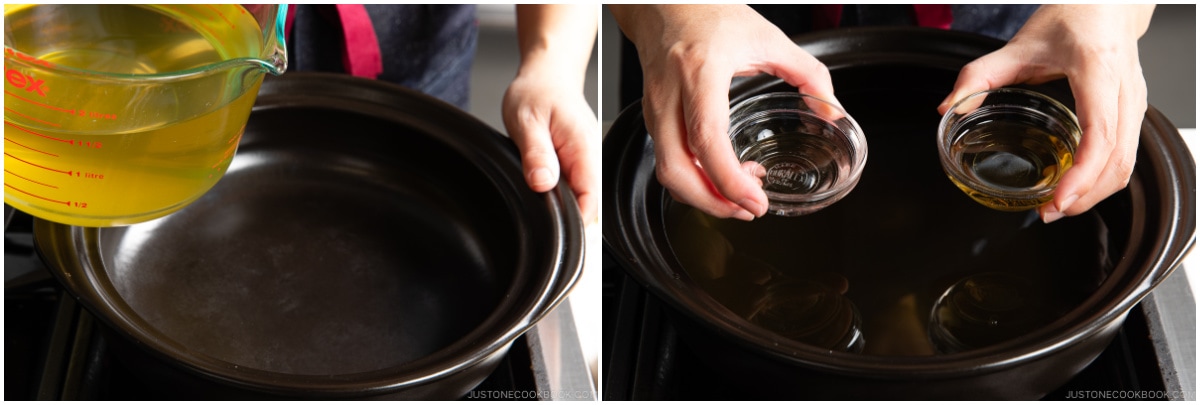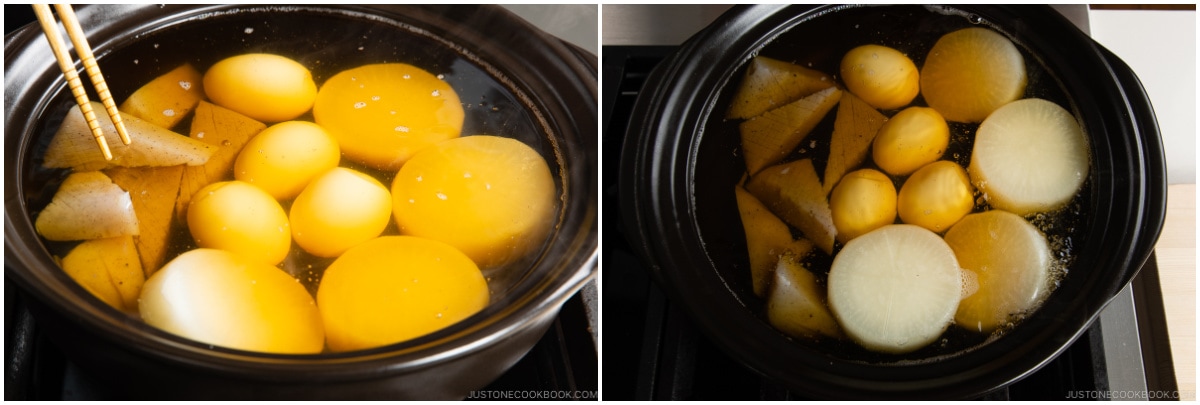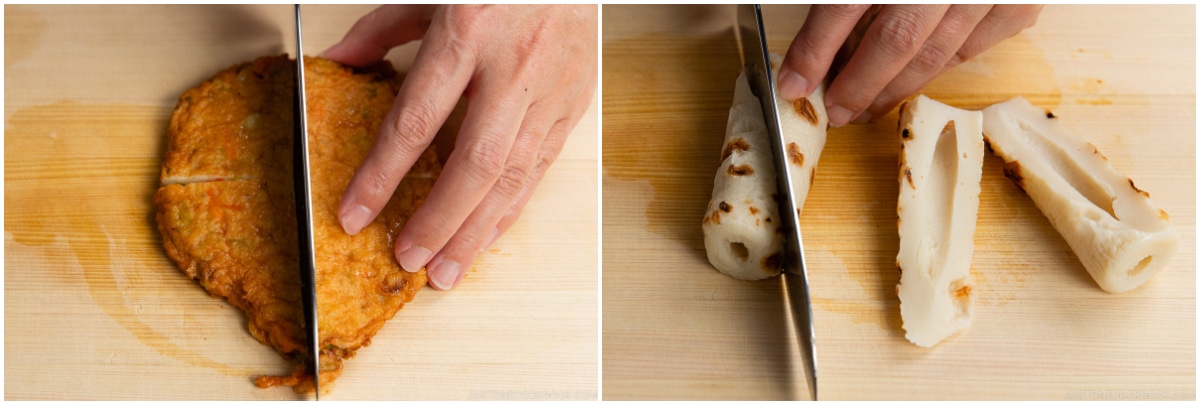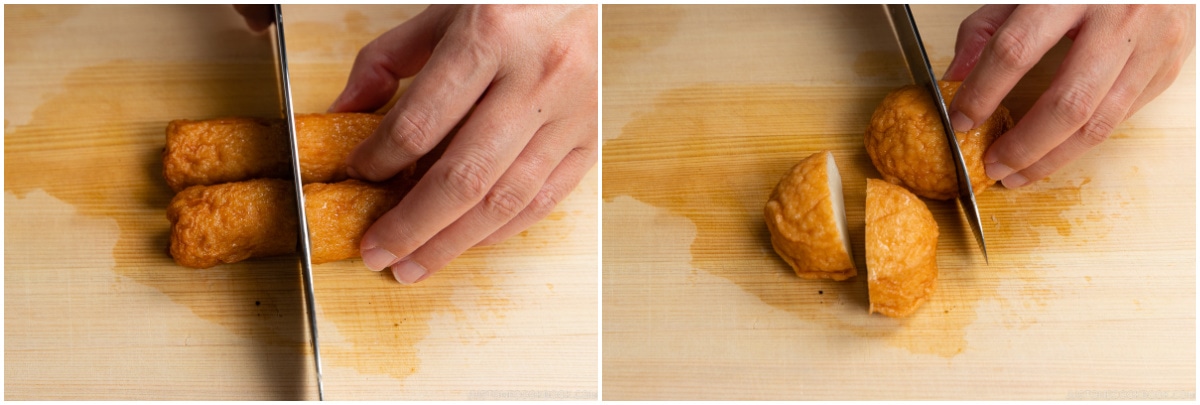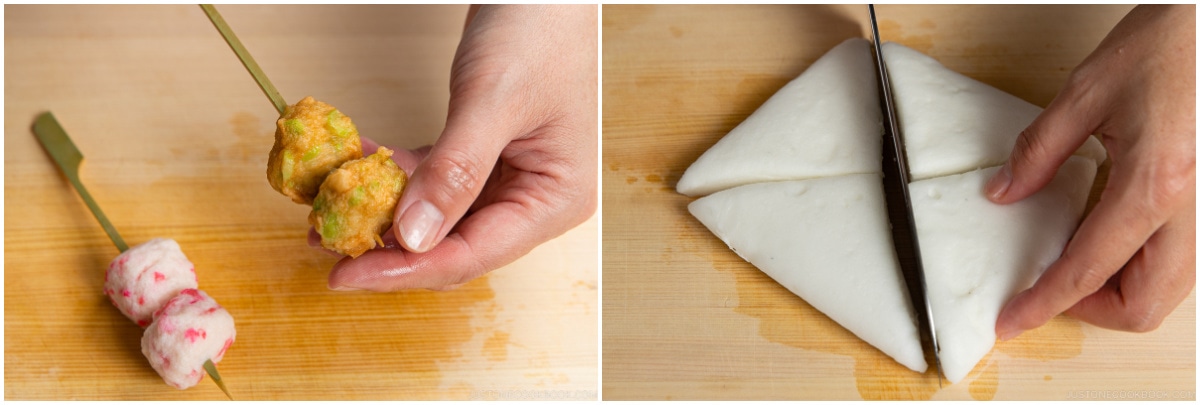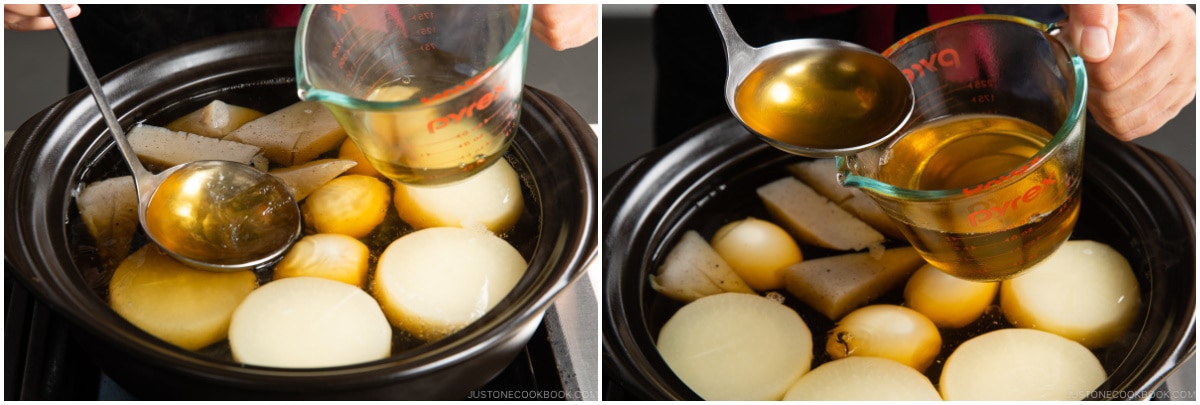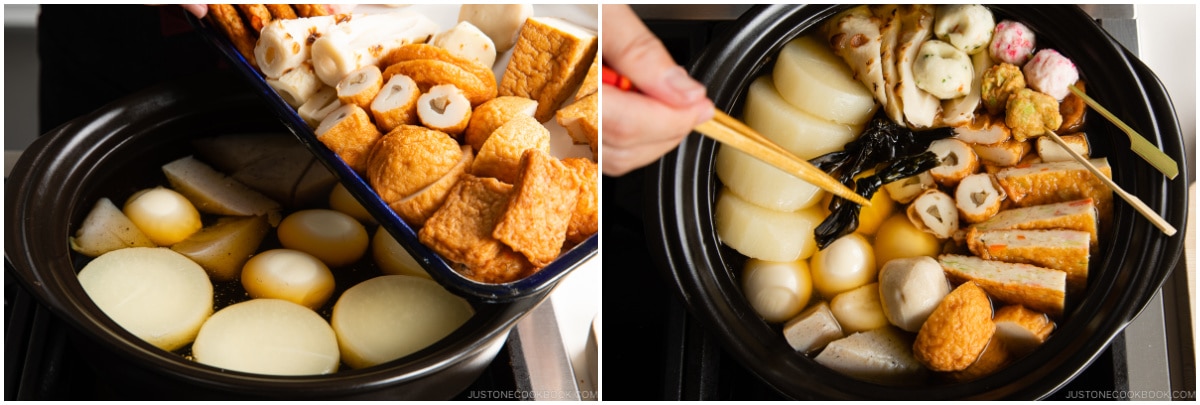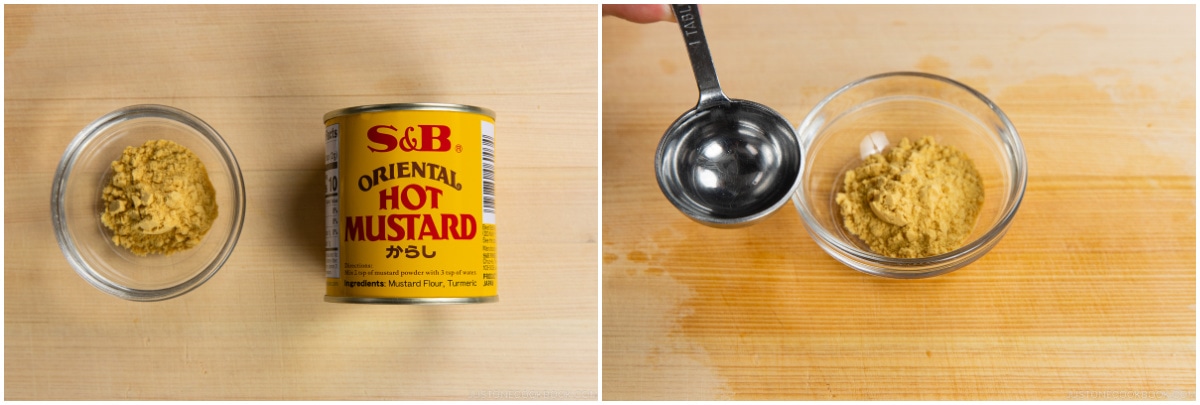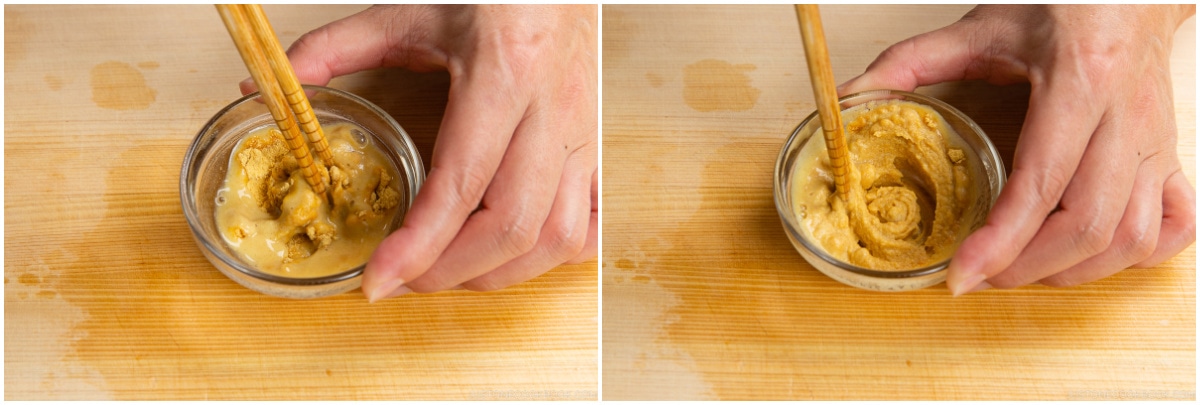There are many opportunities for family and friends to get together during the year-end holiday season. How about a recipe that represents the best of wintertime foods in Japan? Oden (おでん) or Japanese fish cake stew is a warm and comforting dinner to share with family and friends when the weather turns cold. It can be made in large quantities at once so it’s a perfect dish for gatherings. Although there are regional variations in each area of Japan, let me introduce a simple, classic oden today.
What is Oden?
Oden is a one-pot dish, which is a little bit different from stew or hot pot. It’s more like a simmered dish, in which you can find assorted fish cakes, daikon radish, atsuage (deep-fried tofu), hard-boiled eggs, konnyaku, kombu, and mochi-filled fried tofu pockets gently cooked in a soy sauce-based broth. You can eat oden at specialty restaurants (see above) and izakaya-style restaurants all year round. When it’s winter, you start to see oden sold at supermarkets, depa-chika (department store’s underground food floor), and konbini (Japanese convenience stores). If you’re lucky, you may see street stalls that sell oden. If you are familiar with Japanese dramas or cartoons, you have probably seen scenes of salarymen eating oden and drinking sake at a food stand at night with their coworkers after a day of work. This special dish has even spread to other Asian countries. When I visited Taiwan, I was surprised to find that the 7-Elevens sell oden (關東煮).
Brief History of Oden
The origin of oden started from a different dish called dengaku (also called Miso Dengaku), with skewered tofu or konnyaku (konjac) boiled and eaten with miso. Later, instead of using miso, different ingredients were cooked in dashi broth, and this became oden that we enjoy today. Despite its mostly brownish appearance from the fish cakes, oden is brimming with comfort. Partaking in a pot of oden is about enjoying each juicy, chewy, and textural bite of the ingredients. Once you try it, you’ll surely fall in love with this winter meal.
Ingredients for Classic Oden
The following are the basic oden ingredients.
Broth: Awase Dashi (Japanese soup stock made with kombu and katsuobushi), sake, mirin, soy sauce, and salt. Assorted fish cakes and fish balls (nerimono) – see the next section for more info. Daikon radish Konnyaku (Konjac) Boiled eggs – Start cooking the eggs in water. Once boiling, cook for 8 minutes. Drain, cool immediately, and peel. Knotted kombu: If you can’t find this, hydrate a large piece of kombu, cut it into individual strips, and tie a knot in each; if the hydrated kombu is very thick and not pliable, cut it into smaller strips or squares and skip tying the knots.
Other Oden Ingredients (optional):
Depending on the region, the ingredients used in oden can be vastly different (see this reference; really interesting!). Feel free to add your favorites besides what’s listed above.
Potatoes – I recommend using Yukon gold potatoes instead of Russet potatoes so the shape of the potatoes remain after simmering Satoimo (Japanese taros) Boiled octopus or squid Gyusuji (beef tendon) Chicken wings Pork offal Spareribs Sausages Shirataki noodles Cabbage rolls Bean sprouts, and more!
How to Make the Best Oden at Home
What is Nerimono (Japanese Fish Cakes and Fish Balls)
Nerimono (練り物) is a blanket term for fish cakes and fish balls that are made of surimi (すり身 “ground flesh”). You may be more familiar with individual nerimono names such as kamaboko, chikuwa, hanpen, and satsuma-age. Surimi is made of white fish—typically Alaska pollock and Pacific whiting—that is pulverized into a thick paste and mixed with seasonings and other ingredients. Then, the paste is formed into various shapes, such as balls, sticks, tubes, and cakes, in different sizes. Depending on the variety, the fish cakes and fish balls are steamed, grilled, boiled, or deep-fried. Since oden is a popular dish, you can buy a variety pack of popular nerimono selections, which we call “Oden Set.” This assorted set contains 10-12 types of nerimono. It’s perfect for cooking oden at home!
Where to Buy Nerimono
Japanese grocery stores and well-stocked Asian grocery stores carry different types of nerimono, typically in the freezer section.
Different Kinds of Nerimono
There are so many kinds of nerimono (check this out), but here are some popular ones.
Atsuage – Deep-fried thick tofu Chikuwa – Grilled fish cake tube Ganmodoki or Ganmo for short – Fried tofu fritters with chopped vegetables, shiitake mushrooms, and hijiki seaweed Gobo-maki – Deep-fried fish cake stick stuffed with gobo in the center Hanpen – Steamed pounded fish cakes that come in square shape Ika-maki – Deep-fried fish cake stick stuffed with squid in the center Mochi kinchaku – Deep-fried tofu pockets that contain mochi Satsuma age – Deep-fried fish cakes that come in flat oblong/round/ shape or balls Tsumire – Fish ball made from sardines Vegetable Tempura – Deep-fried fish cake with vegetables that come in flat oblong/round/ shape
If you have a hard time finding the oden set or various fish cakes in your area, you may be able to get fish cakes that are more popular outside of Japan such as:
Kamaboko (fish cake) Naruto-maki (white fish cake with a red swirl pattern) Kanikama (imitation crab meat)
You could add different ingredients besides nerimono to make oden.
Oden Cooking Tips
Tip #1: Choose various fish cakes and fish balls
Even though the fish cakes and fish balls all look somewhat similar, they are made of different types of fish and ingredients, yielding contrasting flavors and textures. You’d want to use a variety of nerimono to add a fun and interesting element to your oden.
Tip #2: Make good dashi (Japanese soup stock)
The base of the oden broth is dashi. It is what gives the ingredients like fish cakes, fish balls, daikon, boiled eggs, and fried tofu all the delicious flavor. Therefore, it’s important to make really good dashi for oden. The most common type of dashi used for oden is Awase Dashi, a combination of kombu and katsuobushi. You can make it from scratch, which takes 20 minutes, or use a convenient dashi packet that takes 3 minutes.
Tip #3: Don’t skip the daikon and konnyaku prep
On a busy day when I have to prepare a meal quickly, I may skip some additional prepping steps when they are not crucial for the final result. However, in Japanese cooking, there are some important steps you shouldn’t skip. When you make the oden recipe, you must prep the daikon and konnyaku because they are difficult for the flavor to permeate.
Daikon radish: Thick rounds of the daikon take a long time to absorb the flavors of the broth. When the daikon doesn’t absorb enough flavors, it’s bland and tasteless. Therefore, removing the sharp edge of the daikon pieces, scoring the flat surface of the daikon, and boiling it first before simmering it in the oden broth are all important preps you shouldn’t skip. Konnyaku: As you are probably aware, konnyaku has a unique smell and it’s best to get rid most of it by boiling before simmering it in the oden broth.
When you’re ready to cook oden, make sure to start cooking the daikon, konnyaku, and boiled eggs for 20 minutes in the oden broth before adding fish cakes and fish balls.
Tip #4: Blanch the fish cakes and fish balls
Why do we blanch fish cakes and fish balls first? This step helps get rid of the excess deep-frying oil from factory processing and keeps the oden broth clean. Some recipes may suggest just pouring hot water over them, but I find submerging and blanching the whole fish cakes and fish balls in boiling water for 15-30 seconds yield a better result.
Tip #5: Be aware of Nerimono cooking time
Overcooking the nerimono is a big no-no! The fish cakes and fish balls will become too soft and break easily, resulting in a cloudy broth. The nerimono should have a springy texture, so the total simmering time should be 10-15 minutes! Add all the nerimono to the oden broth, except for mochi kinchaku and hanpen, and simmer for 10 minutes. Then, add the last two ingredients and cook for 3 minutes. Important tip: Simmer the oden on gentle heat; NEVER boil, or else the broth will become cloudy.
Tip #6: Enjoy Oden the Next Day!
Last but not least, I must mention that we really enjoy the well-seasoned, day-old oden! All the ingredients absorb more flavors from the broth while it cools down and rests overnight. Just be careful not to overcook while reheating. Some people prefer a firmer texture of nerimono while others (like us) may not bother too much. I often make oden ahead of time. I serve the oden as a side dish on Day 1 and as a main dish on Day 2.
How to Eat Oden
When oden is done simmering, transfer the big pot to the dining table and keep it hot. Oden is very much a communal, social meal that we share, cook, and enjoy from the middle of the dining table, just like other hot pot dishes. We would serve it with a little bit of karashi (Japanese hot mustard) on the side. I included how to prepare it in the recipe card. If you serve oden in a donabe (Japanese clay pot), the food stays warm in it for a long time due to its incredible heat-retention ability. You can also reheat it on a portable butane gas stove while eating, but make sure to keep it on a gentle simmer.
Sake Pairing with Oden
Oden is a fun food to share with friends and family during the winter. With an assortment of fish cakes and other ingredients, it’s a festive feast that’s easy to prepare. We like to pair oden with sake as it’s one of the most versatile drinks to go with various types of Japanese food. During the holidays or hot days, one of our favorite sake to pair with oden is Sho Chiku Bai Shirakabegura MIO Sparkling Sake. This unique sparkling sake has a refreshing fruity aroma and is surprisingly easy to pair with savory foods. As the refreshing bubbles hit your mouth, you can taste the slight sweetness and delicate fruity notes. The sake itself is smooth and creamy and the sparkling texture offers a nice crispy finish. It’s a fantastic way to refresh your palate between different types of oden. Our friends who we’ve introduced MIO to are always surprised by how delicious it is. Plus its low ABV (5%) allows light drinkers to enjoy it as well.
Where to Buy a Donabe (Japanese Clay Pot)
You can cook and serve oden in a Dutch oven, but if you enjoy making all kinds of hot pot dishes, I highly recommend getting a donabe, a traditional Japanese clay pot. Japanese hot pots, nabemono (鍋物), are a necessary remedy for cold weather. Read my post on Japanese Hot Pot 101: All About Nabemono to learn the basics on how to prepare nabemono and 13 delicious recipes to make at home. Wish to learn more about Japanese cooking? Sign up for our free newsletter to receive cooking tips & recipe updates! And stay in touch with me on Facebook, Pinterest, YouTube, and Instagram. Editor’s Note: This post was originally published on January 19, 2012. It’s been republished on December 4, 2022, with the revised recipe, new images, and updated content with more information.
